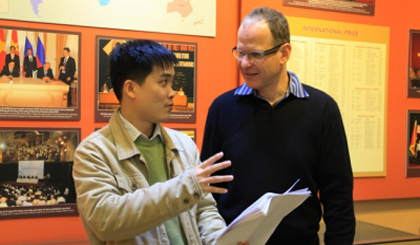Journey to sequence the Vietnamese human genome
The successful sequencing of the genome of a people is highly significant because it is the key to hidden secrets about the history of biological development and characteristics. Recently a group of scientists added Vietnam to the list of 20 countries successfully sequencing the genome of their peoples.
 |
| Dr Le Sy Vinh is discussing scientific matters with his colleague. |
The secret behind the highway map
In a simple and unadorned staffroom with its window overlooking a line of green African mahogany trees, Dr Le Sy Vinh at the Faculty of Information Technology at the University of Engineering and Technology – Vietnam National University in Hanoi (VNU-UET) talks about the dream of his, and his colleagues, of sequencing the Vietnamese human genome. Combining both information technology and biotechnology, the project has the participation of 12 members from VNU-UET, the VNU Information Technology Institute, the Hanoi University of Science and Technology (HUST) and Oxford University.
The genome of a human being contains all of the genetic information that determines their biological development and characteristics. Once the genome of an individual is sequenced and analysed, scientists can reveal information about the development process of that individual and forecast diseases from which they are at risk of suffering. The genomes of two separate individuals are virtually the same with only 0.1% difference.
Using specialised equipment and with thorough analysis, scientists can draw a map of the human genome like drawing a map of highways. By following and adding important information to each “route”, scientists can determine which genes are responsible for protein metabolism, which genes cause certain diseases and genetic differences that make one person different from another.
Individuals of the same ethnicity usually bear the common biological characteristics of that group. If the genomes of many individuals are sequenced, we can have a clearer picture of the biological development and characteristics of an ethnicity as well as their history of development and migration. Beyond that, it helps complete the migration routes of human races on the global anthropological map. Dr Vinh says on that map, Vietnam remains a mysterious black spot. During their research, his team also paid close attention to how migration relates to the Vietnamese people. According to Dr Vinh, they have achieved some early results and will continue the endeavour to decode much more information.
Wide-ranging applications
Adding Vietnam to the list of 20 countries successfully sequencing the human genome of their peoples is a scientific breakthrough. In the near future, there will be an application that can detect more than 3,000 genetic disorders in order to develop early prevention and treatment plans. The effect of the project will spread beyond the laboratory. In an interview with Nhan Dan, Dr Le Sy Vinh shared his vision about practical applications for this project in the future. He says costs aside, the first issue facing them is developing a full process in order to build and analyse the genome of an individual, from collecting and analysing data, to finding out and understanding new knowledge.
This is a big and complicated mathematical problem with many different stages, requiring a broad knowledge in multiple disciplines from molecular biology to information technology, especially big data processing. Thus developing a complete process that is appropriate to Vietnam’s conditions is the most difficult problem.
Regarding computing capabilities, HUST and VNU-UET have large computing systems but they are not dedicated to processing large maths problems such as building and analysing the human genome, says Dr Vinh, adding that they have to design an appropriate computing process that can run on existing systems.
The whole process from the beginning to the announcement of the successful sequencing in 2013 lasted about three years. At the end of 2013, the team received raw data on the genome of a Vietnamese individual. The data contained more than 108 billion nucleotides containing the genetic information of that individual. On that basis, the research team began building and analysing the genome of this individual using modern and highly accurate technology and computing methods on VNU-UET and HUST’s computing systems.
The research group used bioinformatics methods and tools to build the genome from raw data collected, and analyse the genome to work out and understand the differences compared with the standard human genome data as well as the genomes of other races. The result is that the genome sequenced by the team contained more than three million single-nucleotide polymorphisms (SNPs) compared with the human reference genome. Many new SNPs are only found in the Vietnamese human genome. Analytical data also found some other new structural polymorphisms.
The process to build and analyse the human genome brings many benefits to other fields, notably medicine, pharmaceuticals, biotechnology and anthropology. More importantly, genetic analysis and research will help doctors devise individually-oriented prevention and treatment strategies.
There are many diseases caused by gene mutations and these studies will act as the precursor to find harmful changes, thereby discovering diseases that a person could suffer from, and working out preventive and therapeutic measures tailored to that individual. Dr Vinh says in the future the team will work with medical scientists and large hospitals to provide this service.
(Source: nhandan.org.vn)
 về đầu trang
về đầu trang




